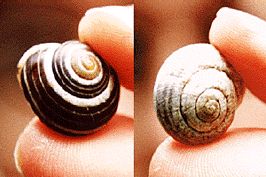Natural selection and variation - How do populations show variation?

Organisms show variety at a number of different levels:
1. The morphologic level
At this level, the individuals of a natural population will be found to vary for almost any character we may measure. Pictured opposite: a much studied instance of variation is shell color in the common snail Cepaea nemoralis.
• Continuous variation
In some characters, like body size, every individual differs from every other individual.
• Discrete variation
Other characters fall into a limited number of categories. Within the peppered moth population, for example, there are two main wing color forms (the dark, melanic form and the light, peppered form). A population that contains more than one recognizable form is polymorphic. As the number of forms in the population increases, the polymorphic, categoric kind of variation blurs into the continuous kind of variation.
2. The cellular level
At this level, such as the number and structure of chromosomes, we again find variation. Chromosomes can vary in their banding patterns (the order of genes) and individuals can vary in their number of chromosomes. At the DNA level the greatest amount of variation is found: DNA sequencing has shown that two individuals with indistinguishable phenotypes can have different genetic make-ups.
In natural populations the requirement of variation, as well as of reproduction and heredity, is met at all levels. However, if natural selection is to take place there must not only be variation: the variation must be for fitness.
| Next |



